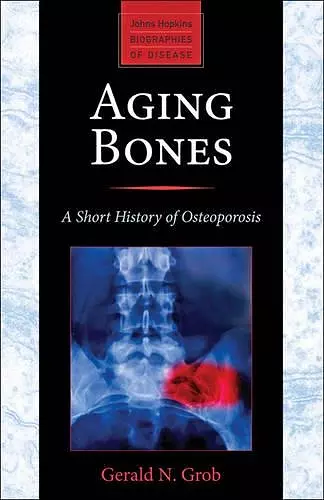Aging Bones
A Short History of Osteoporosis
Format:Paperback
Publisher:Johns Hopkins University Press
Published:15th Apr '14
Currently unavailable, and unfortunately no date known when it will be back

Elegantly written and deeply researched, Aging Bones shows how osteoporosis went from being treated as an inevitable part of getting older to a pathological disease state. An account that traverses Shakespearean sonnets to hormone replacement therapy, Grob's study contains important lessons for historians as well as for millions of women who are advised to stave off frailty through daily doses of Vitamin D, exercise, and estrogen. -- Beth Linker, University of Pennsylvania
The fascinating history in Aging Bones will appeal to students and scholars in the history of medicine, health policy, gerontology, endocrinology, and orthopedics, as well as anyone who has been diagnosed with osteoporosis.In the middle of the twentieth century, few physicians could have predicted that the modern diagnostic category of osteoporosis would emerge to include millions of Americans, predominantly older women. Before World War II, popular attitudes held that the declining physical and mental health of older persons was neither preventable nor reversible and that older people had little to contribute. Moreover, the physiological processes that influenced the health of bones remained mysterious. In Aging Bones, Gerald N. Grob makes a historical inquiry into how this one aspect of aging came to be considered a disease. During the 1950s and 1960s, as more and more people lived to the age of 65, older people emerged as a self-conscious group with distinct interests, and they rejected the pejorative concept of senescence. But they had pressing health needs, and preventing age-related decline became a focus for researchers and clinicians alike. In analyzing how the normal aging of bones was transformed into a medical diagnosis requiring treatment, historian of medicine Grob explores developments in medical science as well as the social, intellectual, economic, demographic, and political changes that transformed American society in the post-World War II decades. Though seemingly straightforward, osteoporosis and its treatment are shaped by illusions about the conquest of disease and aging. These illusions, in turn, are instrumental in shaping our health care system. While bone density tests and osteoporosis treatments are now routinely prescribed, aggressive pharmaceutical intervention has produced results that are inconclusive at best. The fascinating history in Aging Bones will appeal to students and scholars in the history of medicine, health policy, gerontology, endocrinology, and orthopedics, as well as anyone who has been diagnosed with osteoporosis.
A well-written and compelling book that should convince academic, student, lay and professional audiences alike that immersion in the history of a disease is indispensable to treating it. Social History of Medicine [ Aging Bones] illustrate[s] the disparate yet powerful components of chronic disease for understanding medical practices and policies in the twentieth and twenty-first centuries. Journal of the History of Medicine and Allied Sciences Grob's account is well written, clear and comprehensive in scope...should prove useful to any historian of medicine and will be especially valuable to historians interested in gerontology and women's health. Isis
ISBN: 9781421413181
Dimensions: 216mm x 140mm x 18mm
Weight: 363g
304 pages